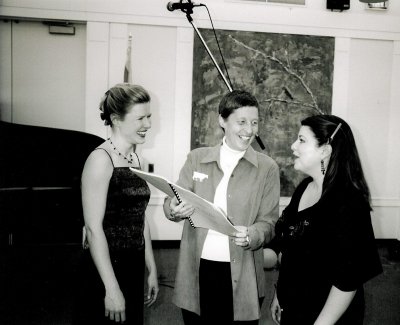Return to Gwyneth Walker Music Catalog
Read a review of the CD The Sun Is Love, vocal music by Gwyneth Walker, NATS: Journal of Singing.
Download an MP3 file of an excerpt from the first movement ("Circling the Sun") of this work performed by Michelle Areyzaga, soprano and Jamie Shaak, piano.
Download an MP3 file of the complete fourth movement ("The Sunrise Ruby") of this work.
Download an MP3 file of excerpts from the sixth movement ("A Waterbird (Flying into the Sun)") of this work.
View a video presentation of a performance of the sixth movement ("A Waterbird (Flying into the Sun)") of this work by Michelle Areyzaga, piano and Jamie Shaak, piano.
Download a PDF file of the score of this composition. This file of excerpted sample pages is for perusal only and is not printable. To hear MP3 files of the complete songs, see the above links.
Download a PDF file of the poetry used in this work as text for printing in concert programs.
(Photograph of Jamie Shaak, Gwyneth Walker, and Michelle Areyzaga in rehearsals for this work.)

The poetry of Jelaluddin Rumi (1207-1273) is seamless. Some poems are lengthy, with images spinning out into many directions. Other poems are fragments, joining together to offer varying views of love. And thus, The Sun is Love is a flowing set of songs intended to be presented as a whole. The language of Rumi (brilliantly translated by Coleman Barks) may enfold the listener as the course of the songs progresses.
The opening song, "Circling the Sun," introduces the title phrase of "the sun is love," along with the image of the lover as a "speck circling the sun." This song is intended to draw the listener into the world of romance which is central to Rumi's writings. Sacredness and love.
"Quietness" is a brief reflection of the letting go (dying) of the self in surrender to love, and to the new self which begins "on the other side."
"Light and Wine and Pomegranate Flowers" is a set of short flirtation songs. She entices her lover to the orchard in Spring, their souls dance. She tells him of the mysteries of life, and then chastises him when he falls asleep as she sings (!).
The musical settings of these three songs endeavor to capture the simplicity and variety of the Rumi style: the joyful circling of the sun, the passionate surrender to love and the bouncy flirtatiousness. The occasional strumming of the strings inside the piano is intended as caresses. Each song has a different character.
"The Sunrise Ruby," is a passionate song. She asks "Do you love me or yourself more?" He answers "There's nothing left of me...I'm like a ruby held up to the sunlight." As he surrenders to love, the piano expresses the warmth of the ruby. The interval of the second, which opens and closes the song, symbolizes the closeness of the two lovers.
"Dualities" is a lighthearted group of song-fragments, each expressing a contradictory set of aspects of love. She has insomnia when her lover is present (staying up all night together) and when he is absent (distraction). Looking outward for love, and looking within. Love as pain, and the sweet cold water that cures the pain. Holding the lover close like a lute, or tossing stones (teasingly) at the beloved. In keeping with the dualities topic of the lyrics, each song employs opposing musical elements: high and low ranges of the piano, alternations between two chords, or gentle strumming (lute) vs. scampering intervals (tossing stones).
"A Waterbird" is a pure love song, without teasing or flirtation. The lover seeks the other ("What I want is to see your face") and seeks a union with love ("to swim like a huge fish in ocean water," and "I want to sing like birds sing..."). The final surrender comes with the phrase "I am a waterbird flying into the sun." With this, the piano accompaniment rises to the end of the keyboard, and the singer stands with arms outstretched to the sun.
Notes by the composer